Gut microbiota of children with autism spectrum disorder and healthy siblings: A comparative study
- Authors:
- Dalia Abuljadayel
- Asalah Alotibi
- Khloud Algothmi
- Fatemah Basingab
- Safiah Alhazmi
- Asma Almuhammadi
- Amani Alharthi
- Reem Alyoubi
- Ahmad Bahieldin
-
Affiliations: Department of Biological Sciences, Faculty of Science, King Abdulaziz University, Jeddah 21589, Saudi Arabia, Department of Biology, College of Science in Zulfi, Majmaaha University, Zulfi 11932, Saudi Arabia, College of Medicine, King Abdulaziz University, Jeddah 22252, Saudi Arabia - Published online on: September 16, 2024 https://doi.org/10.3892/etm.2024.12719
- Article Number: 430
-
Copyright: © Abuljadayel et al. This is an open access article distributed under the terms of Creative Commons Attribution License.
This article is mentioned in:
Abstract
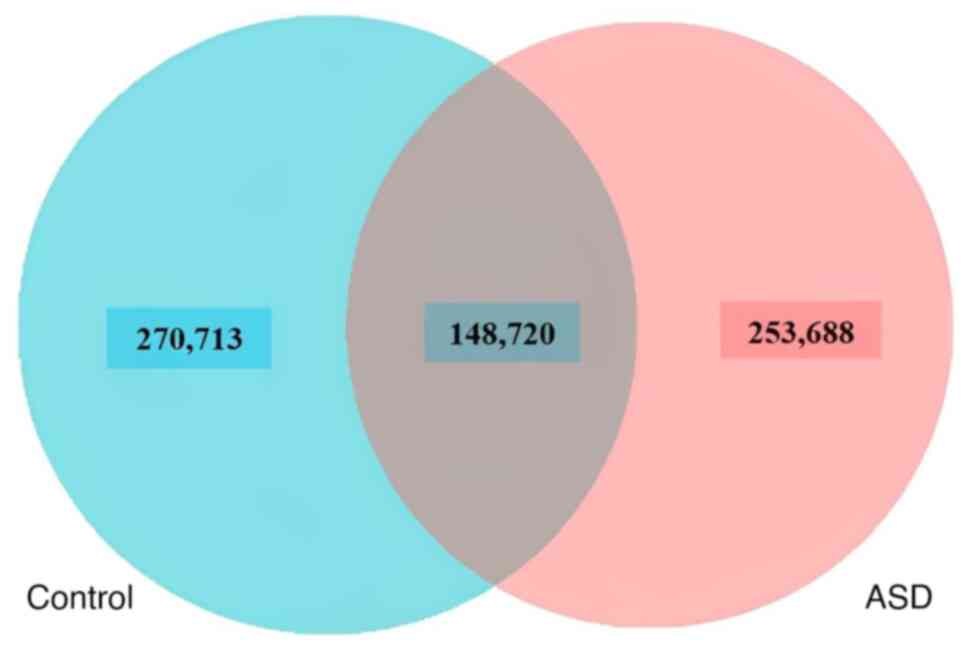 |
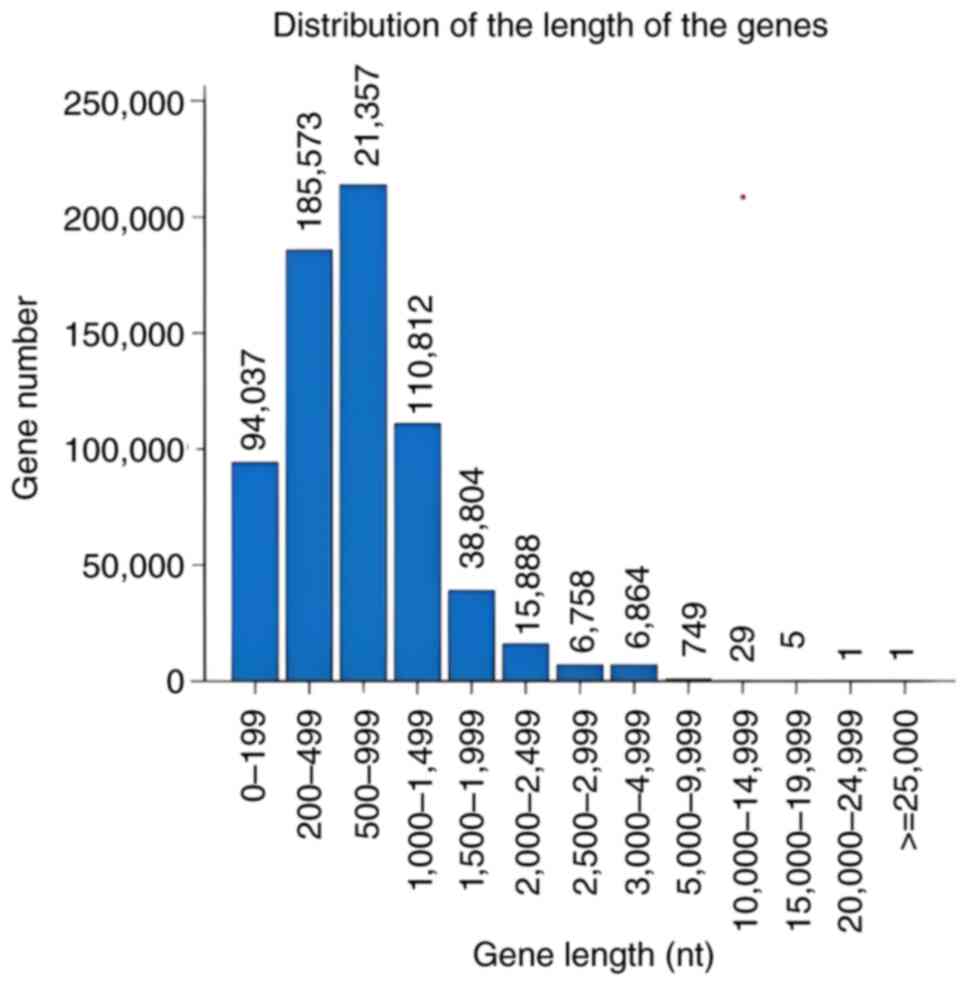 |
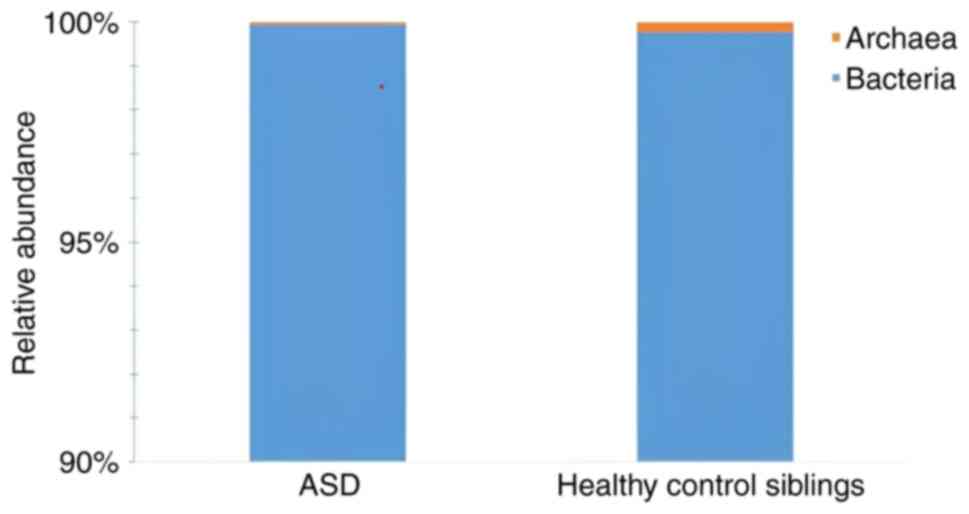 |
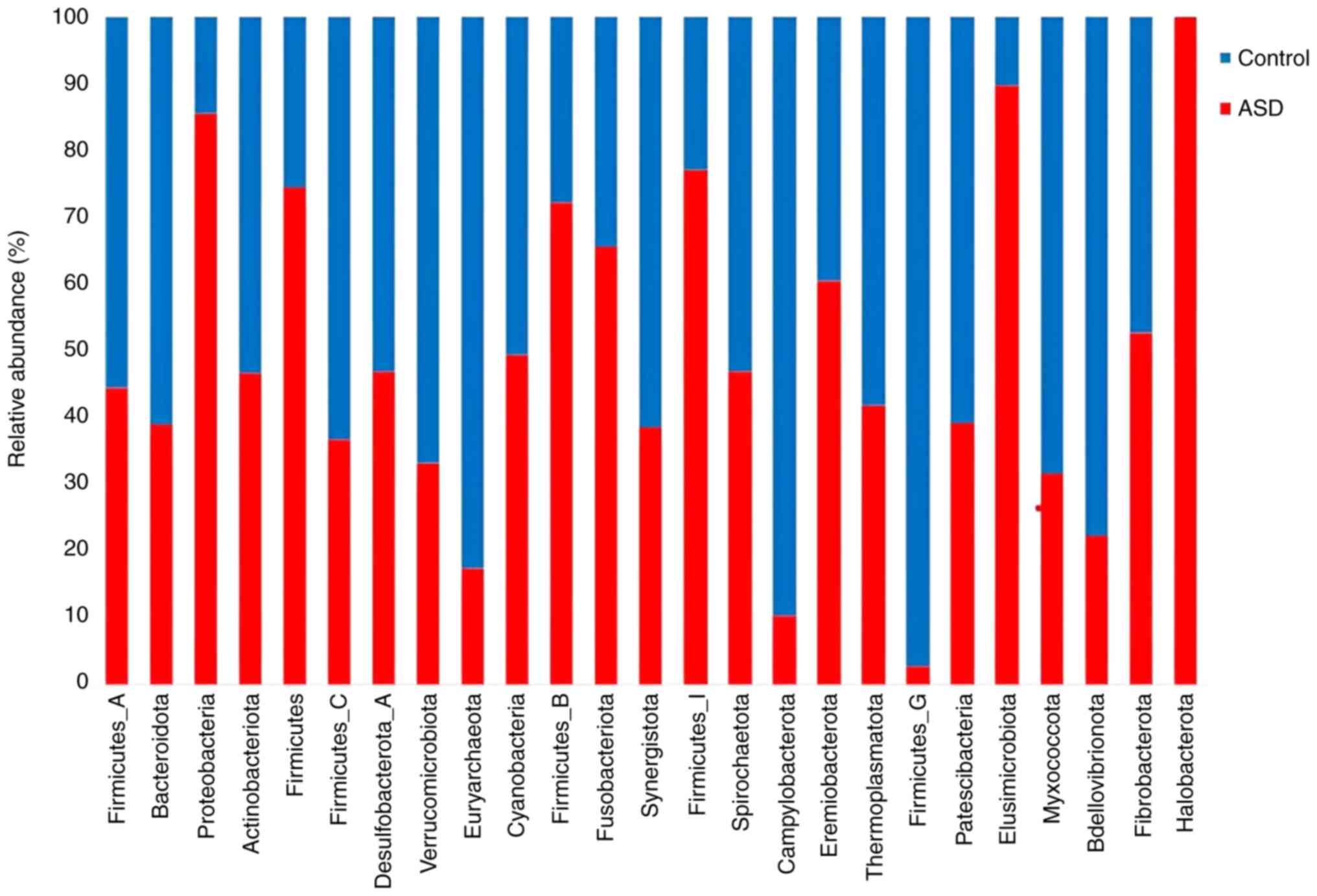 |
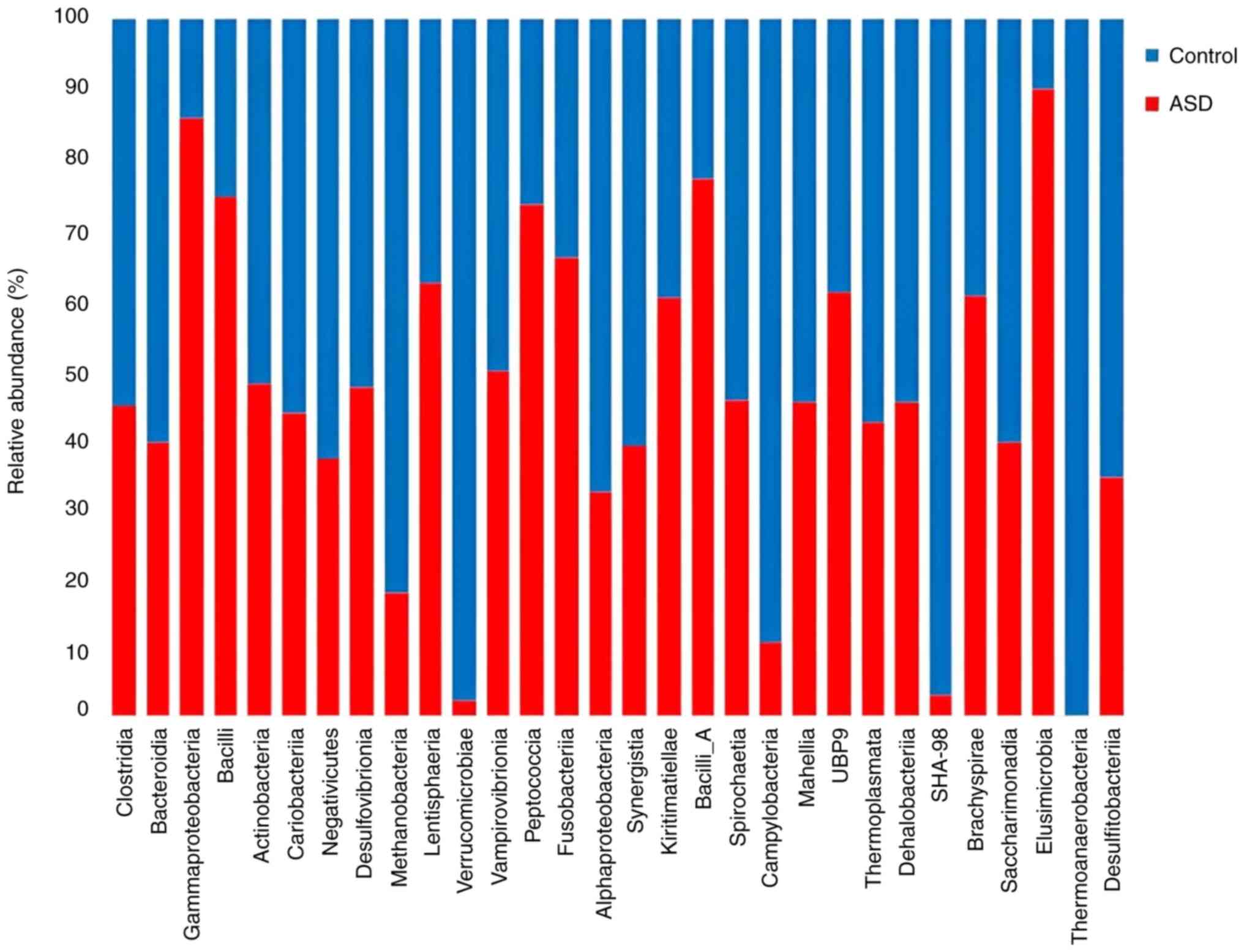 |
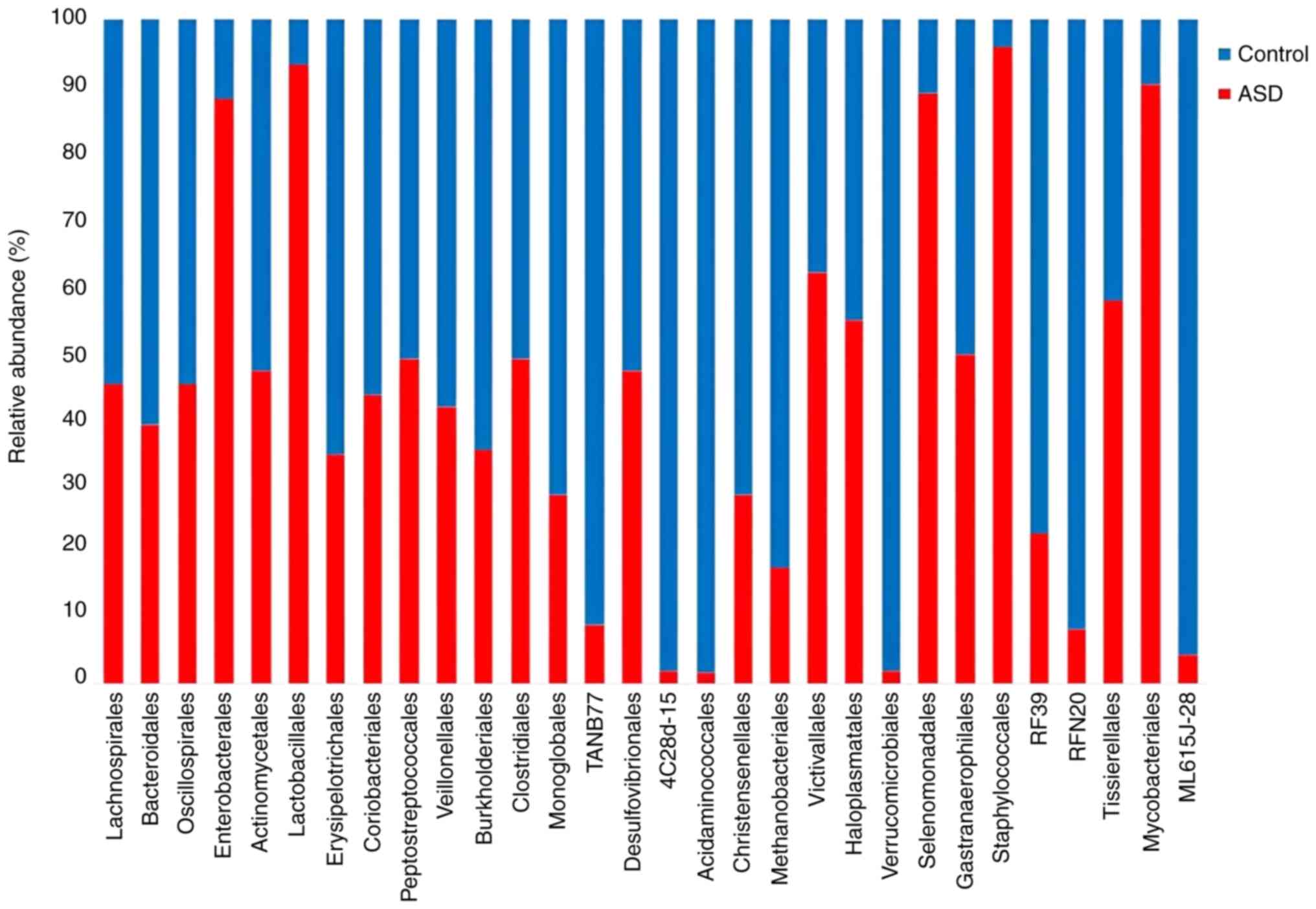 |
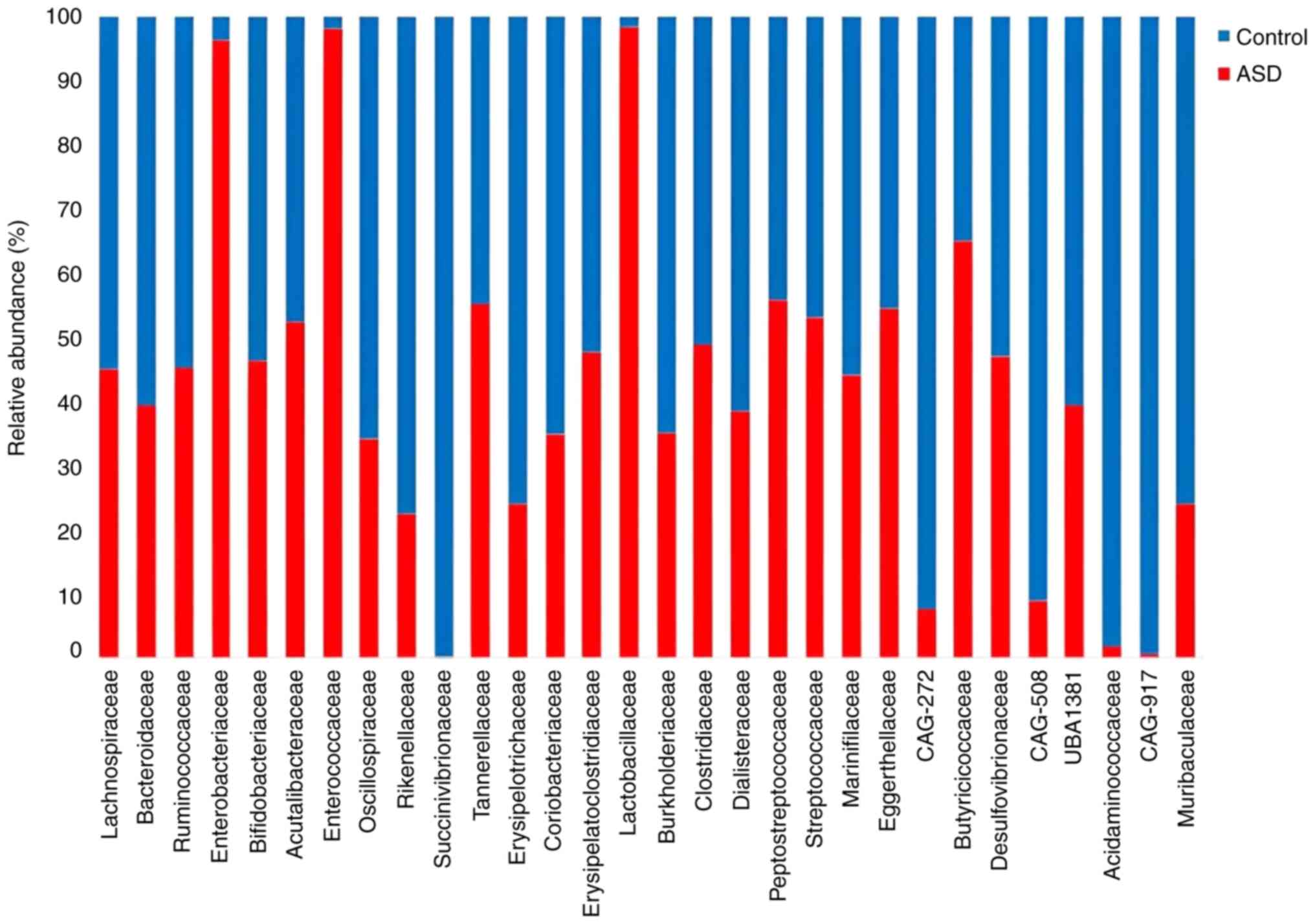 |
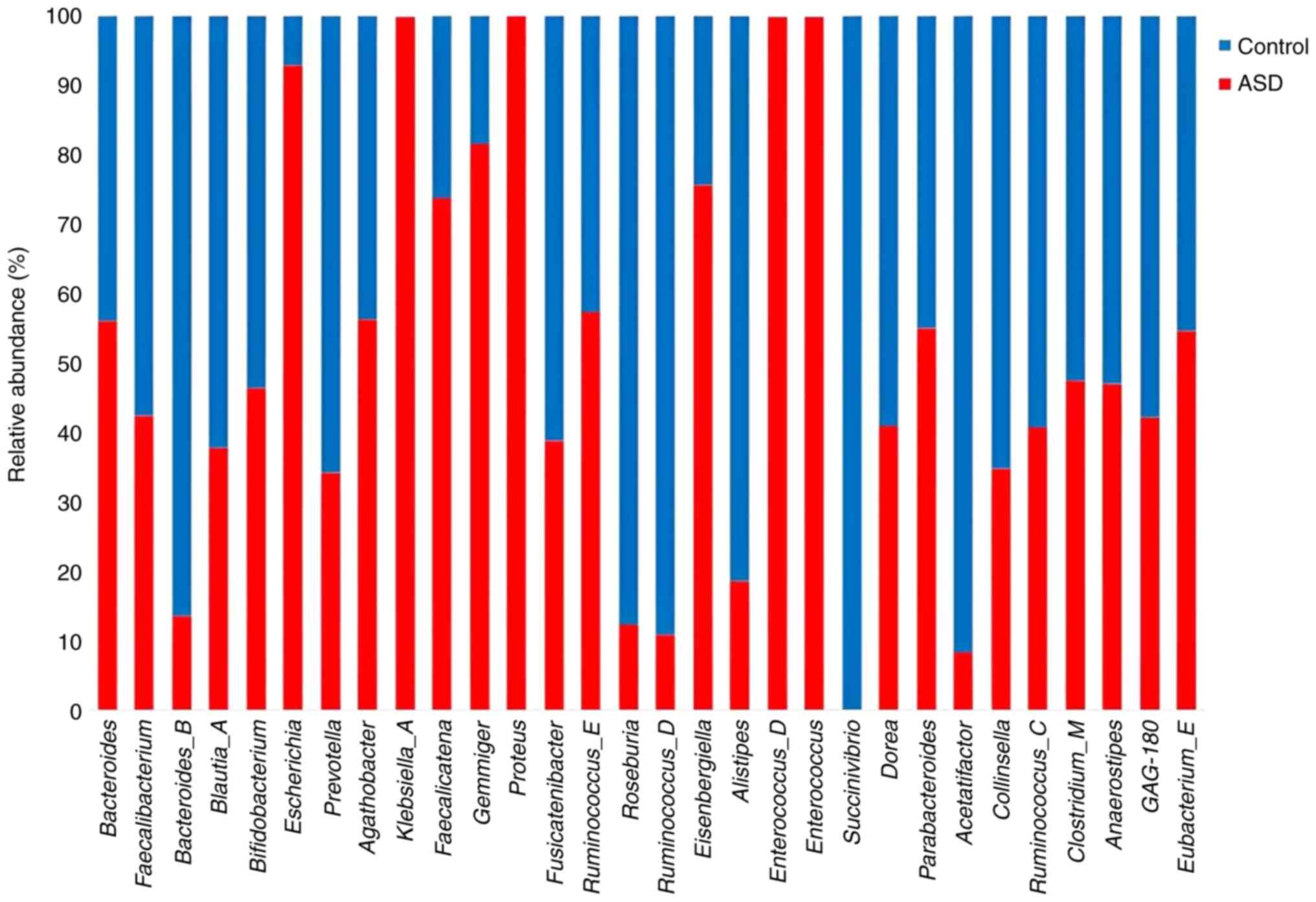 |
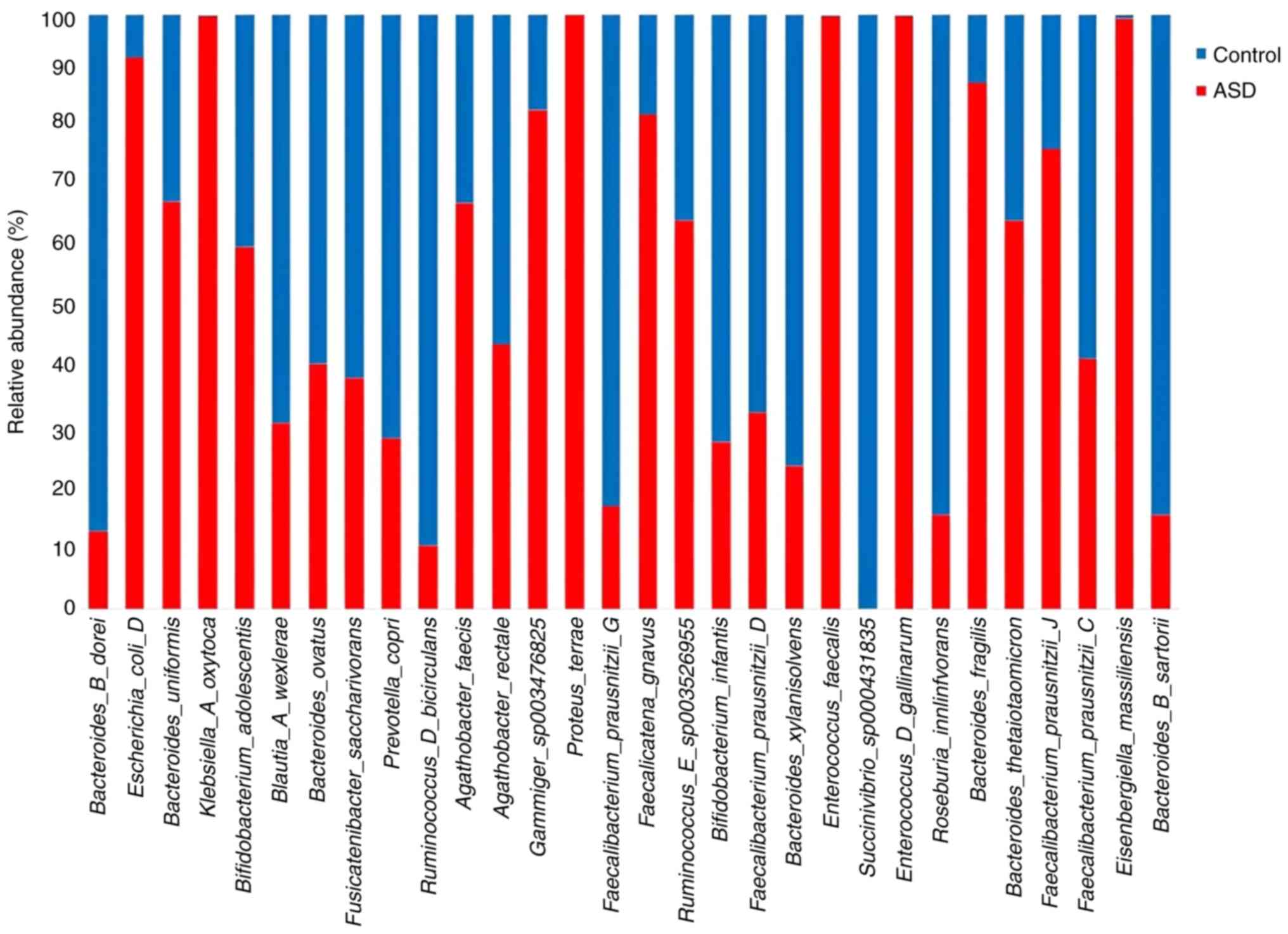 |
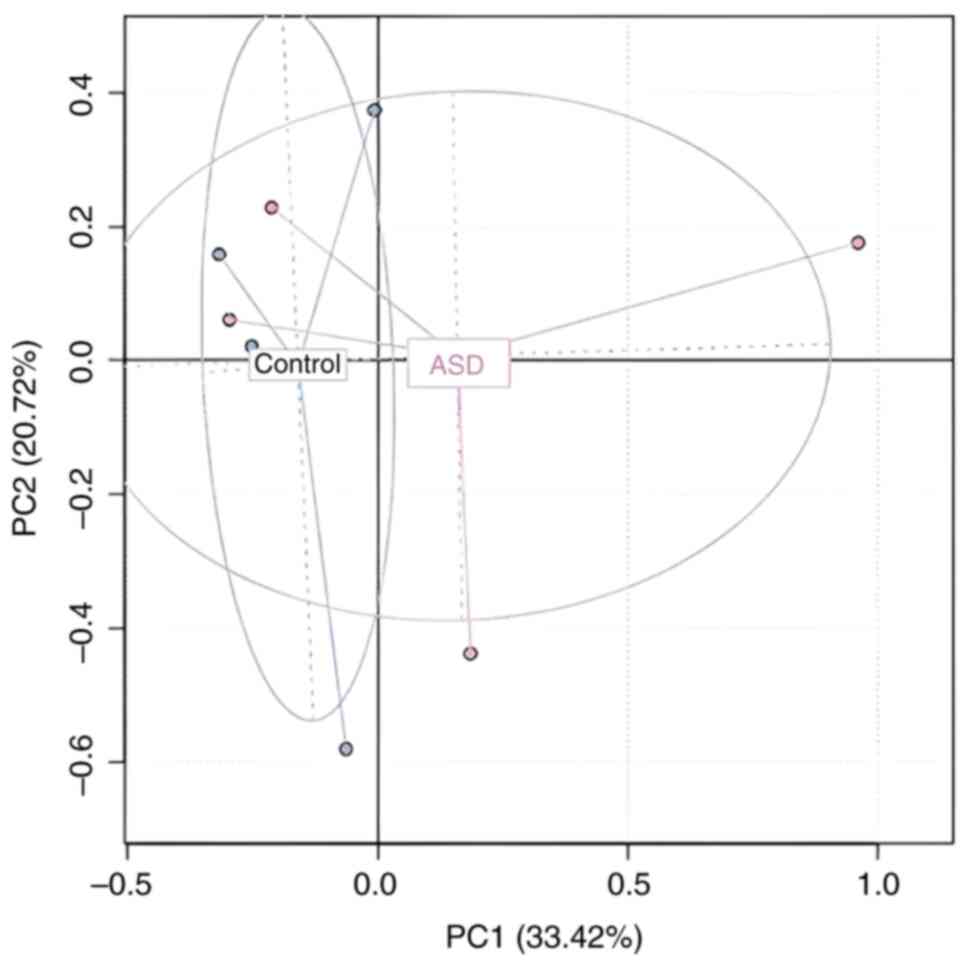 |
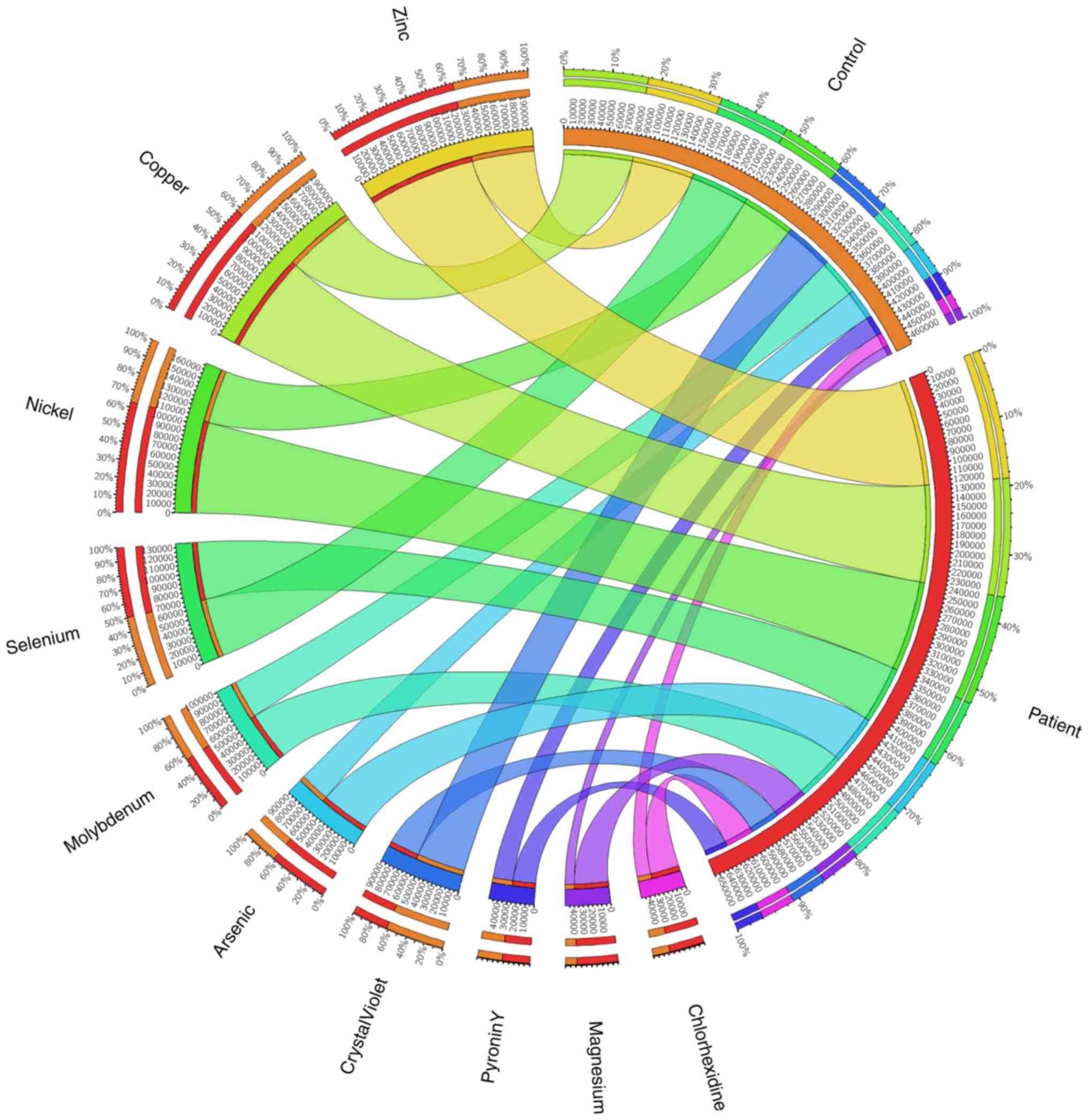 |
|
Bölte S, Girdler S and Marschik PB: The contribution of environmental exposure to the etiology of autism spectrum disorder. Cell Mol Life Sci. 76:1275–1297. 2019.PubMed/NCBI View Article : Google Scholar | |
|
Kral TVE, Eriksen WT, Souders MC and Pinto-Martin JA: Eating behaviors, diet quality, and gastrointestinal symptoms in children with autism spectrum disorders: a brief review. J Pediatr Nurs. 28:548–556. 2013.PubMed/NCBI View Article : Google Scholar | |
|
Mukherjee SB: Autism spectrum disorders-diagnosis and management. Indian J Pediatr. 84:307–314. 2017.PubMed/NCBI View Article : Google Scholar | |
|
Heintz-Buschart A and Wilmes P: Human gut microbiome: Function matters. Trends Microbiol. 26:563–574. 2018.PubMed/NCBI View Article : Google Scholar | |
|
Schären OP and Hapfelmeier S: Robust microbe immune recognition in the intestinal mucosa. Genes Immun. 22:268–275. 2021.PubMed/NCBI View Article : Google Scholar | |
|
Ellis JL, Karl JP, Oliverio AM, Fu X, Soares JW, Wolfe BE, Hernandez CJ, Mason JB and Booth SL: Dietary vitamin K is remodeled by gut microbiota and influences community composition. Gut Microbes. 13:1–16. 2021.PubMed/NCBI View Article : Google Scholar | |
|
Bosco N and Noti M: The aging gut microbiome and its impact on host immunity. Genes Immun. 22:289–303. 2021.PubMed/NCBI View Article : Google Scholar | |
|
Wu J, Wang K, Wang X, Pang Y and Jiang C: The role of the gut microbiome and its metabolites in metabolic diseases. Protein Cell. 12:360–373. 2021.PubMed/NCBI View Article : Google Scholar | |
|
Davoli-Ferreira M, Thomson CA and McCoy KD: Microbiota and microglia interactions in ASD. Front Immunol. 12(676255)2021.PubMed/NCBI View Article : Google Scholar | |
|
Han VX, Patel S, Jones HF and Dale RC: Maternal immune activation and neuroinflammation in human neurodevelopmental disorders. Nat Rev Neurol. 17:564–579. 2021.PubMed/NCBI View Article : Google Scholar | |
|
Kushak RI, Sengupta A and Winter HS: Interactions between the intestinal microbiota and epigenome in individuals with autism spectrum disorder. Dev Med Child Neurol. 64:296–304. 2022.PubMed/NCBI View Article : Google Scholar | |
|
Morais LH, Schreiber HL and Mazmanian SK: The gut microbiota-brain axis in behaviour and brain disorders. Nat Rev Microbiol. 19:241–255. 2021.PubMed/NCBI View Article : Google Scholar | |
|
Zengeler KE and Lukens JR: Innate immunity at the crossroads of healthy brain maturation and neurodevelopmental disorders. Nat Rev Immunol. 21:454–468. 2021.PubMed/NCBI View Article : Google Scholar | |
|
Shreiner AB, Kao JY and Young VB: The gut microbiome in health and in disease. Curr Opin Gastroenterol. 31:69–75. 2015.PubMed/NCBI View Article : Google Scholar | |
|
Mirzaei MK and Maurice CF: Ménage à trois in the human gut: Interactions between host, bacteria and phages. Nat Rev Microbiol. 15:397–408. 2017.PubMed/NCBI View Article : Google Scholar | |
|
Saurman V, Margolis KG and Luna RA: Autism spectrum disorder as a brain-gut-microbiome axis disorder. Dig Dis Sci. 65:818–828. 2020.PubMed/NCBI View Article : Google Scholar | |
|
Lefter R, Ciobica A, Timofte D, Stanciu C and Trifan A: A descriptive review on the prevalence of gastrointestinal disturbances and their multiple associations in autism spectrum disorder. Medicina (Kaunas). 56(11)2019.PubMed/NCBI View Article : Google Scholar | |
|
Penzol MJ, Salazar de Pablo G, Llorente C, Moreno C, Hernández P, Dorado ML and Parellada M: Functional gastrointestinal disease in autism spectrum disorder: A retrospective descriptive study in a clinical sample. Front Psychiatry. 10(179)2019.PubMed/NCBI View Article : Google Scholar | |
|
Kang V, Wagner GC and Ming X: Gastrointestinal dysfunction in children with autism spectrum disorders. Autism Res. 7:501–506. 2014.PubMed/NCBI View Article : Google Scholar | |
|
Bresciani G, Da Lozzo P, Lega S, Bramuzzo M, Di Leo G, Dissegna A, Colonna V, Barbi E, Carrozzi M and Devescovi R: Gastrointestinal disorders and food selectivity: Relationship with sleep and challenging behavior in children with autism spectrum disorder. Children (Basel). 10(253)2023.PubMed/NCBI View Article : Google Scholar | |
|
Lasheras I, Real-López M and Santabárbara J: Prevalence of gastrointestinal symptoms in autism spectrum disorder: A meta-analysis. An Pediatr (Engl Ed). 99:102–110. 2023.PubMed/NCBI View Article : Google Scholar | |
|
Li Q, Han Y, Dy ABC and Hagerman RJ: The gut microbiota and autism spectrum disorders. Front Cell Neurosci. 11(120)2017.PubMed/NCBI View Article : Google Scholar | |
|
Breitwieser FP, Lu J and Salzberg SL: A review of methods and databases for metagenomic classification and assembly. Brief Bioinform. 20:1125–1136. 2019.PubMed/NCBI View Article : Google Scholar | |
|
Mehra A, Arora G, Kaur M, Singh H, Singh B and Kaur S: Gut microbiota and autism spectrum disorder: From pathogenesis to potential therapeutic perspectives. J Tradit Complement Med. 13:135–149. 2022.PubMed/NCBI View Article : Google Scholar | |
|
Mead J and Ashwood P: Evidence supporting an altered immune response in ASD. Immunol Lett. 163:49–55. 2015.PubMed/NCBI View Article : Google Scholar | |
|
Chen YC, Lin HY, Chien Y, Tung YH, Ni YH and Gau SSF: Altered gut microbiota correlates with behavioral problems but not gastrointestinal symptoms in individuals with autism. Brain Behav Immun. 106:161–178. 2022.PubMed/NCBI View Article : Google Scholar | |
|
Zhao Y, Wang Y, Meng F, Chen X, Chang T, Huang H, He F and Zheng Y: Altered gut microbiota as potential biomarker biomarkers for autism spectrum disorder in early childhood. Neuroscience. 523:118–131. 2023.PubMed/NCBI View Article : Google Scholar | |
|
Korteniemi J, Karlsson L and Aatsinki A: Systematic review: Autism spectrum disorder and the gut microbiota. Acta Psychiatr Scand. 148:242–254. 2023.PubMed/NCBI View Article : Google Scholar | |
|
Zhong JG, Lan WT, Feng YQ, Li YH, Shen YY, Gong JH, Zou Z and Hou X: Associations between dysbiosis gut microbiota and changes of neurotransmitters and short-chain fatty acids in valproic acid model rats. Front Physiol. 14(1077821)2023.PubMed/NCBI View Article : Google Scholar | |
|
Kennedy MS and Chang EB: The microbiome: Composition and locations. Prog Mol Biol Transl Sci. 176:1–42. 2020.PubMed/NCBI View Article : Google Scholar | |
|
Feng P, Zhao S, Zhang Y and Li E: A review of probiotics in the treatment of autism spectrum disorders: Perspectives from the gut-brain axis. Front Microbiol. 14(1123462)2023.PubMed/NCBI View Article : Google Scholar | |
|
Davies C, Mishra D, Eshraghi RS, Mittal J, Sinha R, Bulut E, Mittal R and Eshraghi AA: Altering the gut microbiome to potentially modulate behavioral manifestations in autism spectrum disorders: A systematic review. Neurosci Biobehav Rev. 128:549–557. 2021.PubMed/NCBI View Article : Google Scholar | |
|
Naveed M, Zhou QG, Xu C, Taleb A, Meng F, Ahmed B, Zhang Y, Fukunaga K and Han F: Gut-brain axis: A matter of concern in neuropsychiatric disorders…! Prog Neuropsychopharmacol Biol. Psychiatry. 104(110051)2021.PubMed/NCBI View Article : Google Scholar | |
|
Maiuolo J, Gliozzi M, Musolino V, Carresi C, Scarano F, Nucera S, Scicchitano M, Oppedisano F, Bosco F, Ruga S, et al: The contribution of gut microbiota-brain axis in the development of brain disorders. Front Neurosci. 15(616883)2021.PubMed/NCBI View Article : Google Scholar | |
|
Muller PA, Matheis F, Schneeberger M, Kerner Z, Jové V and Mucida D: Microbiota-modulated CART+ enteric neurons autonomously regulate blood glucose. Science. 370:314–321. 2020.PubMed/NCBI View Article : Google Scholar | |
|
Shi Y, Zhang L, Do KA, Peterson CB and Jenq RR: aPCoA: Covariate adjusted principal coordinates analysis. Bioinformatics. 36:4099–4101. 2020.PubMed/NCBI View Article : Google Scholar | |
|
Finegold SM, Dowd SE, Gontcharova V, Liu C, Henley KE, Wolcott RD, Youn E, Summanen PH, Granpeesheh D, Dixon D, et al: Pyrosequencing study of fecal microflora of autistic and control children. Anaerobe. 16:444–453. 2010.PubMed/NCBI View Article : Google Scholar | |
|
De Angelis M, Piccolo M, Vannini L, Siragusa S, De Giacomo A, Serrazzanetti DI, Cristofori F, Guerzoni ME, Gobbetti M and Francavilla R: Fecal microbiota and metabolome of children with autism and pervasive developmental disorder not otherwise specified. PLoS One. 8(e76993)2013.PubMed/NCBI View Article : Google Scholar | |
|
Shin NR, Whon TW and Bae JW: Proteobacteria: Microbial signature of dysbiosis in gut microbiota. Trends Biotechnol. 33:496–503. 2015.PubMed/NCBI View Article : Google Scholar | |
|
Zhu Y, Carvey PM and Ling Z: Altered glutathione homeostasis in animals prenatally exposed to lipopolysaccharide. Neurochem Int. 50:671–680. 2007.PubMed/NCBI View Article : Google Scholar | |
|
Chauhan A and Chauhan V: Oxidative stress in autism. Pathophysiology. 13:171–181. 2006.PubMed/NCBI View Article : Google Scholar | |
|
Tomova A, Husarova V, Lakatosova S, Bakos J, Vlkova B, Babinska K and Ostatnikova D: Gastrointestinal microbiota in children with autism in Slovakia. Physiol Behav. 138:179–187. 2015.PubMed/NCBI View Article : Google Scholar | |
|
Li QM, Zhou YL, Wei ZF and Wang Y: Phylogenomic insights into distribution and adaptation of Bdellovibrionota in marine waters. Microorganisms. 9(757)2021.PubMed/NCBI View Article : Google Scholar | |
|
Varon M: Selection of predation-resistant bacteria in continuous culture. Nature. 277:386–388. 1979. | |
|
Zou R, Xu F, Wang Y, Duan M, Guo M, Zhang Q, Zhao H and Zheng H: Changes in the gut microbiota of children with autism spectrum disorder. Autism Res. 13:1614–1625. 2020.PubMed/NCBI View Article : Google Scholar | |
|
Espín JC, González-Sarrías A and Tomás-Barberán FA: The gut microbiota: A key factor in the therapeutic effects of (poly)phenols. Biochem Pharmacol. 139:82–93. 2017.PubMed/NCBI View Article : Google Scholar | |
|
Settanni CR, Bibbò S, Ianiro G, Rinninella E, Cintoni M, Mele MC, Cammarota G and Gasbarrini A: Gastrointestinal involvement of autism spectrum disorder: Focus on gut microbiota. Expert Rev Gastroenterol Hepatol. 15:599–622. 2021.PubMed/NCBI View Article : Google Scholar | |
|
Gyawali S and Patra BN: Trends in concept and nosology of autism spectrum disorder: A review. Asian J Psychiatr. 40:92–99. 2019.PubMed/NCBI View Article : Google Scholar | |
|
Pulikkan J, Mazumder A and Grace T: Role of the gut microbiome in autism spectrum disorders. Adv Exp Med Biol. 1118:253–269. 2019.PubMed/NCBI View Article : Google Scholar | |
|
Lowe SE, Jain MK and Zeikus JG: Biology, ecology, and biotechnological applications of anaerobic bacteria adapted to environmental stresses in temperature, pH, salinity, or substrates. Microbiol Rev. 57:451–509. 1993.PubMed/NCBI View Article : Google Scholar | |
|
Lynd LR, Weimer PJ, Van Zyl WH and Pretorius IS: Microbial cellulose utilization: Fundamentals and biotechnology. Microbiol Mol Biol Rev. 66:506–577. 2002.PubMed/NCBI View Article : Google Scholar | |
|
Wiegel J, Mothershed CP and Puls J: Differences in xylan degradation by various noncellulolytic thermophilic anaerobes and Clostridium thermocellum. Appl Environ Microbiol. 49:656–659. 1985.PubMed/NCBI View Article : Google Scholar | |
|
Shukla SK, Khan A and Rao TS: Microbial fouling in water treatment plants. In: Microbial and Natural Macromolecules. Elsevier, pp589-622, 2021. | |
|
Pozuelo M, Panda S, Santiago A, Mendez S, Accarino A, Santos J, Guarner F, Azpiroz F and Manichanh C: Reduction of butyrate- and methane-producing microorganisms in patients with irritable bowel syndrome. Sci Rep. 5(12693)2015.PubMed/NCBI View Article : Google Scholar | |
|
Anderson JR, Carroll I, Azcarate-Peril MA, Rochette AD, Heinberg LJ, Peat C, Steffen K, Manderino LM, Mitchell J and Gunstad J: A preliminary examination of gut microbiota, sleep, and cognitive flexibility in healthy older adults. Sleep Med. 38:104–107. 2017.PubMed/NCBI View Article : Google Scholar | |
|
Plaza-Díaz J, Gómez-Fernández A, Chueca N, Torre-Aguilar MJ, Gil Á, Perez-Navero JL, Flores-Rojas K, Martín-Borreguero P, Solis-Urra P, Ruiz-Ojeda FJ, et al: Autism spectrum disorder (ASD) with and without mental regression is associated with changes in the fecal microbiota. Nutrients. 11(337)2019.PubMed/NCBI View Article : Google Scholar | |
|
Chandarana KA, Gohil K, Dwivedi MK and Amaresan N: Culture-independent and culture-dependent approaches in symbiont analysis. In: Microbial Symbionts. Elsevier, pp723-742, 2023. | |
|
Turnbull PC, Kramer J and Melling J: Bacillus: Chapter 15. Medical microbiology, pp1-7, 1996. | |
|
Bujňáková D, Puvača N and Ćirković I: Virulence factors and antibiotic resistance of Enterobacterales. Microorganisms. 10(1588)2022.PubMed/NCBI View Article : Google Scholar | |
|
Bhakdi S and Tranum-Jensen J: Alpha-toxin of Staphylococcus aureus. Microbiol Rev. 55:733–751. 1991.PubMed/NCBI View Article : Google Scholar | |
|
Gupta RS, Lo B and Son J: Phylogenomics and comparative genomic studies robustly support division of the genus Mycobacterium into an emended genus Mycobacterium and four novel genera. Front Microbiol. 9(67)2018.PubMed/NCBI View Article : Google Scholar | |
|
Manjeese W, Mvubu NE, Steyn AJ and Mpofana T: Mycobacterium tuberculosis-induced maternal immune activation promotes autism-like phenotype in infected mice offspring. Int J Environ Res Public Health. 18(4513)2021.PubMed/NCBI View Article : Google Scholar | |
|
Baldelli V, Scaldaferri F, Putignani L and Del Chierico F: The role of Enterobacteriaceae in gut microbiota dysbiosis in inflammatory bowel diseases. Microorganisms. 9(697)2021.PubMed/NCBI View Article : Google Scholar | |
|
Pulikkan J, Maji A, Dhakan DB, Saxena R, Mohan B, Anto MM, Agarwal N, Grace T and Sharma VK: Gut microbial dysbiosis in Indian children with autism spectrum disorders. Microb Ecol. 76:1102–1114. 2018.PubMed/NCBI View Article : Google Scholar | |
|
Derrien M and van Hylckama Vlieg JE: Fate, activity, and impact of ingested bacteria within the human gut microbiota. Trends Microbiol. 23:354–366. 2015.PubMed/NCBI View Article : Google Scholar | |
|
Martín R, Miquel S, Benevides L, Bridonneau C, Robert V, Hudault S, Chain F, Berteau O, Azevedo V, Chatel JM, et al: Functional characterization of novel Faecalibacterium prausnitzii strains isolated from healthy volunteers: A step forward in the use of F. prausnitzii as a next-generation probiotic. Front Microbiol. 8(1226)2017.PubMed/NCBI View Article : Google Scholar | |
|
Milani C, Ticinesi A, Gerritsen J, Nouvenne A, Lugli GA, Mancabelli L, Turroni F, Duranti S, Mangifesta M, Viappiani A, et al: Gut microbiota composition and Clostridium difficile infection in hospitalized elderly individuals: A metagenomic study. Sci Rep. 6(25945)2016.PubMed/NCBI View Article : Google Scholar | |
|
Labus JS, Hollister EB, Jacobs J, Kirbach K, Oezguen N, Gupta A, Acosta J, Luna RA, Aagaard K, Versalovic J, et al: Differences in gut microbial composition correlate with regional brain volumes in irritable bowel syndrome. Microbiome. 5(49)2017.PubMed/NCBI View Article : Google Scholar | |
|
Bryant MP and Small N: Characteristics of two new genera of anaerobic curved rods isolated from the rumen of cattle. J Bacteriol. 72:22–26. 1956.PubMed/NCBI View Article : Google Scholar | |
|
Wang L, Cen S, Wang G, Lee YK, Zhao J, Zhang H and Chen W: Acetic acid and butyric acid released in large intestine play different roles in the alleviation of constipation. J Funct Foods. 69(103953)2020. | |
|
Ma B, Liang J, Dai M, Wang J, Luo J, Zhang Z and Jing J: Altered gut microbiota in Chinese children with autism spectrum disorders. Front Cell Infect Microbiol. 9(40)2019.PubMed/NCBI View Article : Google Scholar | |
|
Cui Y, Zhang L, Wang X, Yi Y, Shan Y, Liu B, Zhou Y and Lü X: Roles of intestinal Parabacteroides in human health and diseases. FEMS Microbiol Lett. 369(fnac072)2022.PubMed/NCBI View Article : Google Scholar | |
|
Ho LKH, Tong VJW, Syn N, Nagarajan N, Tham EH, Tay SK, Shorey S, Tambyah PA and Law ECN: Gut microbiota changes in children with autism spectrum disorder: A systematic review. Gut Pathog. 12(6)2020.PubMed/NCBI View Article : Google Scholar | |
|
MacFabe DF, Cain DP, Rodriguez-Capote K, Franklin AE, Hoffman JE, Boon F, Taylor AR, Kavaliers M and Ossenkopp KP: Neurobiological effects of intraventricular propionic acid in rats: Possible role of short chain fatty acids on the pathogenesis and characteristics of autism spectrum disorders. Behav Brain Res. 176:149–169. 2007.PubMed/NCBI View Article : Google Scholar | |
|
Hamilton AL, Kamm MA, Ng SC and Morrison M: Proteus spp. as putative gastrointestinal pathogens. Clin Microbiol Rev. 31:e00085–17. 2018.PubMed/NCBI View Article : Google Scholar | |
|
Iglesias-Vázquez L, Van Ginkel Riba G, Arija V and Canals J: Composition of gut microbiota in children with autism spectrum disorder: A systematic review and meta-analysis. Nutrients. 12(792)2020.PubMed/NCBI View Article : Google Scholar | |
|
Srikantha P and Mohajeri MH: The possible role of the microbiota-gut-brain-axis in autism spectrum disorder. Int J Mol Sci. 20(2115)2019.PubMed/NCBI View Article : Google Scholar | |
|
Shen J: Modeling the glutamate-glutamine neurotransmitter cycle. Front Neuroenergetics. 5(1)2013.PubMed/NCBI View Article : Google Scholar | |
|
Horder J, Petrinovic MM, Mendez MA, Bruns A, Takumi T, Spooren W, Barker GJ, Künnecke B and Murphy DG: Glutamate and GABA in autism spectrum disorder-a translational magnetic resonance spectroscopy study in man and rodent models. Transl Psychiatry. 8(106)2018.PubMed/NCBI View Article : Google Scholar | |
|
Wierońska JM, Stachowicz K, Nowak G and Pilc A: The loss of glutamate-GABA harmony in anxiety disorders. Anxiety disord. 24:135–156. 2011. | |
|
Kang DW, Park JG, Ilhan ZE, Wallstrom G, Labaer J, Adams JB and Krajmalnik-Brown R: Reduced incidence of Prevotella and other fermenters in intestinal microflora of autistic children. PLoS One. 8(e68322)2013.PubMed/NCBI View Article : Google Scholar | |
|
McNabney SM and Henagan TM: Short chain fatty acids in the colon and peripheral tissues: A focus on butyrate, colon cancer, obesity and insulin resistance. Nutrients. 9(1348)2017.PubMed/NCBI View Article : Google Scholar | |
|
Scott KP, Martin JC, Campbell G, Mayer CD and Flint HJ: Whole-genome transcription profiling reveals genes up-regulated by growth on fucose in the human gut bacterium ‘Roseburia inulinivorans’. J Bacteriol. 188:4340–4349. 2006.PubMed/NCBI View Article : Google Scholar | |
|
Barratt MJ, Nuzhat S, Ahsan K, Frese SA, Arzamasov AA, Sarker SA, Islam MM, Palit P, Islam MR, Hibberd MC, et al: Bifidobacterium infantis treatment promotes weight gain in Bangladeshi infants with severe acute malnutrition. Sci Transl Med. 14(eabk1107)2022.PubMed/NCBI View Article : Google Scholar | |
|
Högenauer C, Langner C, Beubler E, Lippe IT, Schicho R, Gorkiewicz G, Krause R, Gerstgrasser N, Krejs GJ and Hinterleitner TA: Klebsiella oxytoca as a causative organism of antibiotic-associated hemorrhagic colitis. N Engl J Med. 355:2418–2426. 2006.PubMed/NCBI View Article : Google Scholar | |
|
Herzog KA, Schneditz G, Leitner E, Feierl G, Hoffmann KM, Zollner-Schwetz I, Krause R, Gorkiewicz G, Zechner EL and Högenauer C: Genotypes of Klebsiella oxytoca isolates from patients with nosocomial pneumonia are distinct from those of isolates from patients with antibiotic-associated hemorrhagic colitis. J Clin Microbiol. 52:1607–1616. 2014.PubMed/NCBI View Article : Google Scholar | |
|
Sievert DM, Ricks P, Edwards JR, Schneider A, Patel J, Srinivasan A, Kallen A, Limbago B and Fridkin S: National Healthcare Safety Network (NHSN) Team and Participating NHSN Facilities. Antimicrobial-resistant pathogens associated with healthcare-associated infections: Summary of data reported to the National healthcare safety network at the centers for disease control and prevention, 2009-2010. Infect Control Hosp Epidemiol. 34:1–14. 2013.PubMed/NCBI View Article : Google Scholar | |
|
Molton JS, Tambyah PA, Ang BSP, Ling ML and Fisher DA: The global spread of healthcare-associated multidrug-resistant bacteria: A perspective from Asia. Clin Infect Dis. 56:1310–1318. 2013.PubMed/NCBI View Article : Google Scholar | |
|
Hawari I, Eskandar MB and Alzeer S: The role of lead, manganese, and zinc in autism spectrum disorders (ASDS) and attention-deficient hyperactivity disorder (ADHD): A case-control study on Syrian children affected by the Syrian crisis. Biol Trace Elem Res. 197:107–114. 2020.PubMed/NCBI View Article : Google Scholar | |
|
Faber S, Zinn GM, Kern JC II and Kingston HM: The plasma zinc/serum copper ratio as a biomarker in children with autism spectrum disorders. Biomarkers. 14:171–180. 2009.PubMed/NCBI View Article : Google Scholar | |
|
Ji X, Grandner MA and Liu J: The relationship between micronutrient status and sleep patterns: A systematic review. Public Health Nutr. 20:687–701. 2017.PubMed/NCBI View Article : Google Scholar | |
|
Liu J, Zhou G, Wang Y, Ai Y, Pinto-Martin J and Liu X: Sleep problems, fatigue, and cognitive performance in Chinese kindergarten children. J Pediatr. 161:520–525.e2. 2012.PubMed/NCBI View Article : Google Scholar | |
|
Kawamura T, Ogawa Y, Nakamura Y, Nakamizo S, Ohta Y, Nakano H, Kabashima K, Katayama I, Koizumi S, Kodama T, et al: Severe dermatitis with loss of epidermal Langerhans cells in human and mouse zinc deficiency. J Clin Invest. 122:722–732. 2012.PubMed/NCBI View Article : Google Scholar | |
|
Prasad KM, Watson AMM, Dickerson FB, Yolken RH and Nimgaonkar VL: Exposure to herpes simplex virus type 1 and cognitive impairments in individuals with schizophrenia. Schizophr Bull. 38:1137–1148. 2012.PubMed/NCBI View Article : Google Scholar | |
|
Hagmeyer S, Haderspeck JC and Grabrucker AM: Behavioral impairments in animal models for zinc deficiency. Front Behav Neurosci. 8(443)2015.PubMed/NCBI View Article : Google Scholar | |
|
Cezar LC, Kirsten TB, da Fonseca CCN, de Lima APN, Bernardi MM and Felicio LF: Zinc as a therapy in a rat model of autism prenatally induced by valproic acid. Prog Neuropsychopharmacol Biol Psychiatry. 84:173–180. 2018.PubMed/NCBI View Article : Google Scholar | |
|
Lakshmi Priya MD and Geetha A: Level of trace elements (copper, zinc, magnesium and selenium) and toxic elements (lead and mercury) in the hair and nail of children with autism. Biol Trace Elem Res. 142:148–158. 2011.PubMed/NCBI View Article : Google Scholar | |
|
Samal L and Mishra C: Significance of nickel in livestock health and production. Int J Agro Vet Med Sci. 5:349–361. 2011. | |
|
Denkhaus E and Salnikow K: Nickel essentiality, toxicity, and carcinogenicity. Crit Rev Oncol Hematol. 42:35–56. 2002.PubMed/NCBI View Article : Google Scholar | |
|
Costa-Pinto FA and Basso AS: Neural and behavioral correlates of food allergy. Chem Immunol Allergy. 98:222–239. 2012.PubMed/NCBI View Article : Google Scholar | |
|
Fiore M, Barone R, Copat C, Grasso A, Cristaldi A, Rizzo R and Ferrante M: Metal and essential element levels in hair and association with autism severity. J Trace Elem Med Biol. 57(126409)2020.PubMed/NCBI View Article : Google Scholar | |
|
Das KK, Das SN and Dhundasi SA: Nickel, its adverse health effects & oxidative stress. Indian J Med Res. 128:412–425. 2008.PubMed/NCBI | |
|
Wang M, Hossain F, Sulaiman R and Ren X: Exposure to inorganic arsenic and lead and autism spectrum disorder in children: A systematic review and meta-analysis. Chem Res Toxicol. 32:1904–1919. 2019.PubMed/NCBI View Article : Google Scholar | |
|
Saghazadeh A, Ahangari N, Hendi K, Saleh F and Rezaei N: Status of essential elements in autism spectrum disorder: Systematic review and meta-analysis. Rev Neurosci. 28:783–809. 2017.PubMed/NCBI View Article : Google Scholar | |
|
Zhang C, Ge J, Lv M, Zhang Q, Talukder M and Li JL: Selenium prevent cadmium-induced hepatotoxicity through modulation of endoplasmic reticulum-resident selenoproteins and attenuation of endoplasmic reticulum stress. Environ Pollut. 260(113873)2020.PubMed/NCBI View Article : Google Scholar |









